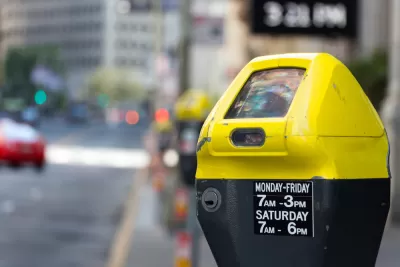San Francisco could become the first U.S. city to use demand-based parking rates citywide.

"Surge pricing could be coming to every parking meter in San Francisco in 2018 under a plan being considered by the Municipal Transportation Agency," reports Michael Cabanatuan.
The city already uses dynamic pricing for 7,000 parking spaces around the city, after its pioneering SFPark pilot program to test the concept concluded in 2014. After the pilot concluded, the MTA continued demand-based pricing "in some of the city’s busiest neighborhoods — downtown, South of Market, the Mission, the Embarcadero, Fisherman’s Wharf, Mission Bay, the Fillmore and the Marina," according to Cabanatuan. If the MTA approves the proposal to extend demand-based dynamic pricing citywide, it would be the first time the concept has been in implemented in more residential neighborhoods.
Cabanatuan also describes the reasoning by the demand-based pricing concept, which will be familiar to anyone who has read Donald Shoup's The High Cost of Free Parking:
MTA officials say the approach is intended to increase the availability of coveted city parking spaces, particularly in areas where demand is high. People unwilling to pay the higher rates might seek parking farther away, remain for a shorter period of time, or leave their car at home.
FULL STORY: SF set to become first US city to price all metered parking based on demand

Alabama: Trump Terminates Settlements for Black Communities Harmed By Raw Sewage
Trump deemed the landmark civil rights agreement “illegal DEI and environmental justice policy.”

Planetizen Federal Action Tracker
A weekly monitor of how Trump’s orders and actions are impacting planners and planning in America.

Why Should We Subsidize Public Transportation?
Many public transit agencies face financial stress due to rising costs, declining fare revenue, and declining subsidies. Transit advocates must provide a strong business case for increasing public transit funding.

Blinded by the Light: When Brighter Headlights Decrease Safety
Bright LED headlights can create glare and reduce visibility for other drivers and pedestrians.

Study Links Covid and Poor Driving
The effects of the virus, including ‘brain fog,’ can make driving more difficult and dangerous.

Waymo Gets Permission to Map SF’s Market Street
If allowed to operate on the traffic-restricted street, Waymo’s autonomous taxis would have a leg up over ride-hailing competitors — and counter the city’s efforts to grow bike and pedestrian on the thoroughfare.
Urban Design for Planners 1: Software Tools
This six-course series explores essential urban design concepts using open source software and equips planners with the tools they need to participate fully in the urban design process.
Planning for Universal Design
Learn the tools for implementing Universal Design in planning regulations.
Caltrans
Smith Gee Studio
Institute for Housing and Urban Development Studies (IHS)
City of Grandview
Harvard GSD Executive Education
Toledo-Lucas County Plan Commissions
Salt Lake City
NYU Wagner Graduate School of Public Service


























